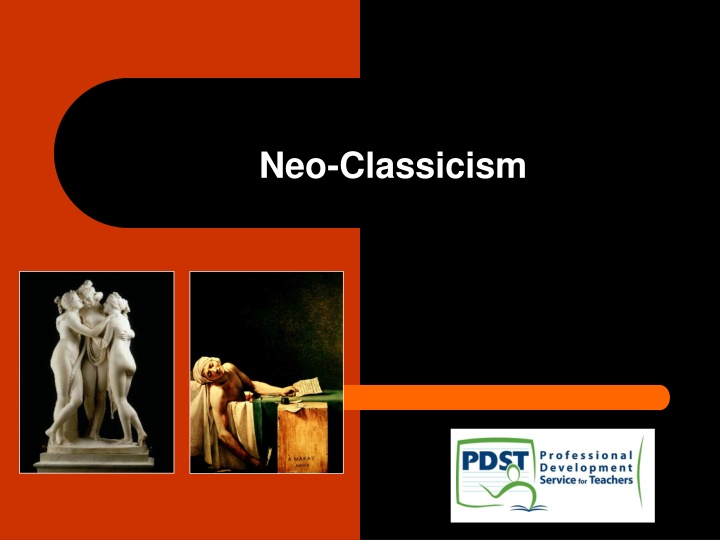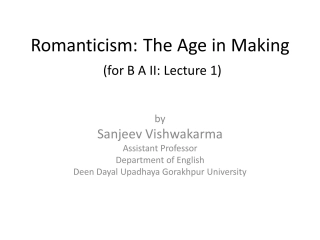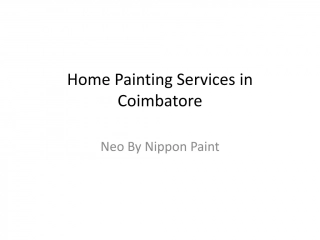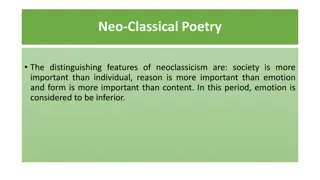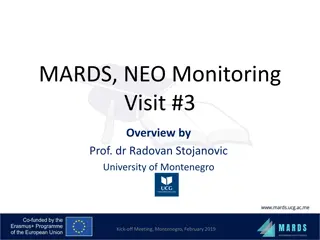Neo-Classicism
Neo-Classicism is a cultural movement inspired by Greek art, seeking simplicity and grandeur. Artists like Jacques Louis David and Jean Dominique Ingres created significant works during this period, such as "The Oath of the Horatii" depicting sacrifice for the state. The style emphasizes geometry, linear perspective, and symmetry.
Download Presentation

Please find below an Image/Link to download the presentation.
The content on the website is provided AS IS for your information and personal use only. It may not be sold, licensed, or shared on other websites without obtaining consent from the author.If you encounter any issues during the download, it is possible that the publisher has removed the file from their server.
You are allowed to download the files provided on this website for personal or commercial use, subject to the condition that they are used lawfully. All files are the property of their respective owners.
The content on the website is provided AS IS for your information and personal use only. It may not be sold, licensed, or shared on other websites without obtaining consent from the author.
E N D
Presentation Transcript
Neo-Classicism is: A revival of the styles and spirit of classic antiquity. Inspired by the classical period of Greek Art . A reaction to the excesses of Rocco art. Aimed at achieving "noble simplicity and calm grandeur . Johann Joachim Winckelmann.
Neo-Classicism Refers to Painting, sculpture and Architecture as well as writing and music. The Grand Tour and fashion for collecting antiquities helped spread the revival of Classical Art throughout Europe. Influence on Architecture.
Important artists Jacques Louis David (1748-1825) Jean Dominique Ingres (1780-1867) Antonio Canova (1757-1822)
JacquesLouis David (1748-1825) David trained in the studio of Boucher. Won the Prix de Rome and studied in Italy for 5 years After the French revolution became a politician with control of much government patronage in art. He had to leave France for exile in Brussels at the restoration of the monarchy in France.
The Oath of the Horatii 1784 Jacques-Louis David http://smarthistory.khanacademy.org/neo-classicism.html#
The Oath of the Horatii 1784 Three Horatii brothers are given swords by their father. They swear an oath to fight until they die for their country. One of the Horatii sisters (pictured on the right) is married to one of the enemy (the Curiatii). One brother survives and returns home. He is condemned by his sister for killing her husband and the father of her children.
Subject matter The surviving brother kills his sister because she puts herself and her family before the good of her country. The idea here is that one must be willing to sacrifice even sacrifice one's life and family members for the state. This idea was very influential on the French revolutionaries of 1789.
Features of the painting Influence of geometry. Linear perspective. Three arches frame the three sets of figures. The triple screen of Doric columns and arches. Muted colours Symmetry
The angle of the light heightens the muscularity of the male figures. The light, which enters the room from the upper left, sharply defines mass and volume. There is an influence of Caravaggio in the physical qualities of the male bodies
http://www.bc.edu/bc_org/avp/cas/his/CoreArt/art/neocl_dav_marat.htmlhttp://www.bc.edu/bc_org/avp/cas/his/CoreArt/art/neocl_dav_marat.html
The Death of Marat Marat, a leader of the Revolution, was stabbed by a young woman called Charlotte Corday while he was in the bath. David paints him in a dignified manner. Marat is dying, head weighing heavily on shoulder, eyes drooping. The letter and knife as well as his pen are included.
The Death of Marat Clear light coming from the top left hand corner illuminates the face, body and objects. The light is soft over the features and gets harsher over the letter in his right hand. The colours are subtle-creams and whites contrast with the green of the blanket and the dark background. The wound is very subtle. David s signature is clearly printed on the crate.
Jean Aguste Dominique Ingres 1780-1867 Student of David Simple, linear style Influenced by Raphael Balanced compositions Idealised forms Sensual images
http://smarthistory.khanacademy.org/grand-odalisque.html La Grande Odalisque, 1814 Jean-Auguste-Dominique Ingres
La Grande Odalisque Painting shows an idealised North African setting. An odalisque is a harem slave. Peacock fan, large pearls, turban and the hookah pipe all part of French perception of the Orient Comparisons and contrasts can be made to Venus of Urbino by Titian (1538)
http://smarthistory.khanacademy.org/grand-odalisque.html http://www.uffizi.org/artworks/venus-of-urbino-by-titian/
La Grande Odalisque Contrast between the dark background and the pale skin. Balanced triangular composition. Her back is unnaturally long-the legs are in a very strange and uncomfortable position. Languid pose. Face in profile with strong use of light from left hand side.
s/the_valpincon_bather http://www.artble.com/artists/jean_auguste_dominique_ingres/painting Valpincon Bather Jean-Auguste-Dominique Ingres
Valpincon Bather Painted in 1808 Appeals to the senses Female nude shown from the back. Full length green curtain on left hand side Nude seated on a bed Wears a turban Angle of right leg very awkward.
Valpincon Bather Paint applied perfectly smoothly Light coming softly from the top left hand side. Soft curves in background draw the viewers eye to seated figure. Colours are soft-creams, whites, greys and greens with pink on turban
Antonio Canova Antonio Canova was born in Venice in 1757 In 1779 Canova visited Rome for the first time, and two years later he returned to settle there permanently. He is regarded as the leading light of Neo- Classical Sculpture. Despite a job in the Vatican as an Art collector he was no slavish imitator. Instead he wished to emulate the works of Ancient Classical artists.
Technique The methods he used demanded absolute precision. Working from numerous preparatory sketches he modelled the form into a life-size clay version. He then cast a plaster model of this which he marked up with points that were transferred on to the marble block.
Antonio Canova His assistants would carve the marble into shape. Only then, for the last hand , did Canova raise his chisel, sculpting the form and polishing the marble, using wax, to a fine, glistening finish.
Psyche Revived by Cupid's Kiss
Psyche Revived by Cupid's Kiss Commissioned in 1787 Exemplifies the Neo-Classical devotion to love and emotion. It represents the god Cupid in the height of love and tenderness, immediately after awakening the lifeless Psyche with a kiss, Appeals to the senses of sight and touch.
Psyche Revived by Cupid's Kiss Having been recently awakened, Psyche reaches up towards her lover, Cupid, as he gently holds her by supporting her head and breast. The two lovers appear to be alive as the execution Antonio Canova has done on the marble shows realistic smooth skin, contrasted by the elements surrounding the two figures.
Psyche Revived by Cupid's Kiss A sheet loosely draped around Psyche s lower body, emphasizes the difference between the texture of skin and drapery. Rough texture provides the basis of the rock upon which the composition is placed. Fine curls and lines provide the hair and light feathery details create realistic wings upon the landing Cupid.
Psyche Revived by Cupid's Kiss The statue is not meant to be immobile. In fact there is a handle near one of Psyche s feet as the statue was meant to revolve rather than remain stationary. Many of Canova s sculptures had custom built settings or a device that would move the base, thus the handle provided for some of the movement of the statue
Antonio Canova, Paolina Borghese as Venus Victorious, 1804-08
Paolina Borghese as Venus Victorious Paolina Borghese was Napoleon Bonaparte's scandalous sister and she chose to be depicted as Venus, the goddess of love. She is shown lying back on a couch. Canova captures the soft texture of her skin. Her head is slightly raised and in her hand she holds an apple
Paolina Borghese as Venus Victorious Her hair, a mass of curls bound in a Psyche knot, serves as a visual connector between old and new, being worn in imitation of ancient Greek styles, as was the fashion of the day. Its careful arrangement offsets the smooth shallow planes of her torso.
Paolina Borghese as Venus Victorious The couch Paolina lies on is carved from a different type of marble. The base part of which is covered in rhythmically flowing drapery, much like on a catafalque (a raised platform used to bear coffins) In Greek and Roman art the reclining female figure is frequently found on sarcophagus lids.
PDST Professional Development Service for Teachers Acknowledgements Many thanks to the following for their invaluable contribution to the European Art History and Appreciation series of workshops and resource materials. Art Associates Maria Moore Margaret O Shea Local Facilitator Team Aine Andrews Joe Caslin Jane Campbell Siobhan Campbell Niamh O Donoghue Niamh O Neill Keith O Rahilly Sheena McKeon Tony Morrissey Monica White
PDST Professional Development Service for Teachers Cultural & Environmental Education Professional Development Service for Teachers (PDST) Dublin West Education Centre, Old Blessington Road, Tallaght, Dublin 24 National Co-ordinator ConorHarrison Mobile: 087 240 5710 E-mail: conorharrison@pdst.ie Administrator Angie Grogan Tel: 014528018 Fax: 014528010 E-mail: angiegrogan@pdst.ie. The PDST is funded by the Department of Education and Skills under the National Development Plan 2007 - 2013
